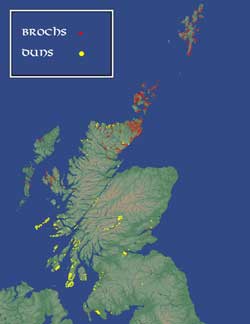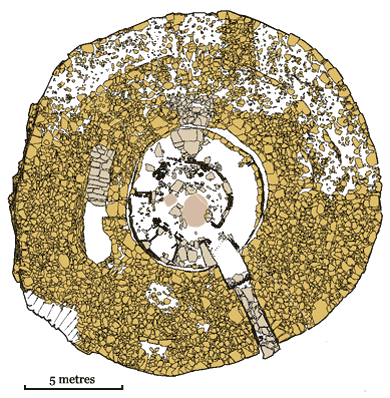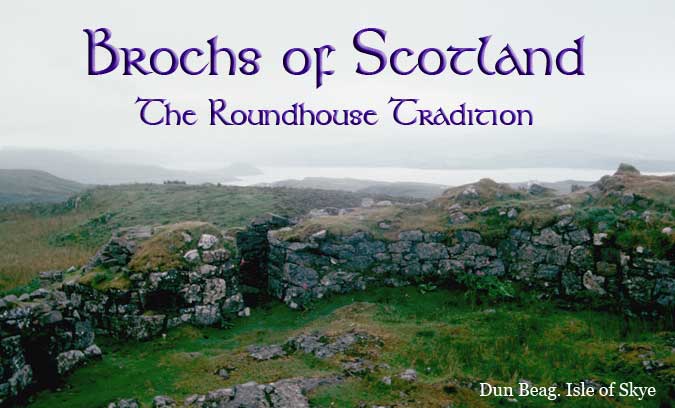
In the past, there was some debate as to whether the brochs were a native idea or whether they were introduced by foreign invaders in much the same way as the Normans introduced the motte-and-bailey castle to help them control a hostile countryside. But now it is generally believed that they were an entirely native development from the local roundhouse tradition. Circular houses had been a distinctive feature of the British landscape for well over a thousand years before brochs appeared, at least since the Early Bronze Age, which began early in the second millennium BC.
In the lowland parts of Scotland, in the south and east, most of these buildings were made out of timber and consequently have not survived except as crop marks in aerial photographs. These show a ring of posts, which—as we know from excavated examples—would have formed the framework for a wattle-and-daub wall supporting a thatched conical roof. In the uplands of northern and western Scotland, timber was a scarce and very valuable resource so stone was used instead. Thousands of these have survived in various states of preservation.
Bu Broch, Orkney
It was John Hedges’ rescue dig at the site of Bu in Orkney that first suggested the connection. Under a mound of loose stone in a farmer’s field overlooking the Bay of Navershaw just east of Stromness, Hedges uncovered a round building 19.5 metres in diameter with a solid outer wall some 5.2 metres thick. Although the thickness of the wall seemed to indicate the building was a broch, excavations revealed that it had been modified during the course of its occupation and that the outer 1½ metres or so had been added later, meaning that originally it would not have supported much weight. Today it survives to a height of about 1½ metres and there is little to suggest it was every any taller (although the site may have been robbed for building material after it was abandoned).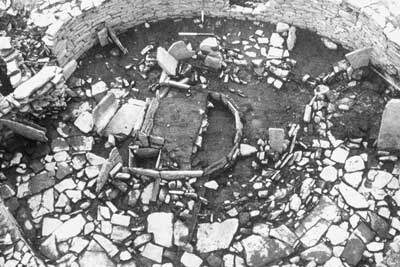
Inside, was a more or less circular area covering about 70 square metres, with a flagstone floor, a central hearth, a stone-lined tank and a stone cupboard. It was partitioned around the perimeter by upright slabs and these were used for storage and sleeping. It is quite possible that the occupants shared their dwelling with their livestock—a fairly common practice in the farming world—which would have kept the inside quite cosy (if somewhat pungent). Four radiocarbon dates have been published from Bu, ranging from the around 800-600 BC.
Even simple roundhouses such as Bu would have been imposing structures, with conical roofs rising as much as 5 metres above the walls. The later thickening of the walls was most likely done in order to make the walls even higher and increase the dramatic effect. Where we have evidence, the roundhouses appear to have stood alone, without any out buildings or other houses.
Crosskirk, Caithness
In the second half of the first millennium BC, roundhouses began to get more complex and one of the best examples of this development is the site of Crosskirk in Caithness, which was excavated by Horace Fairhurst from 1966-72. Radiocarbon evidence suggests that it was occupied for nearly a thousand years, from the eighth century BC until the first couple of centuries AD. As was the case at Bu, the outer wall of the main structure is quite substantial—nearly 6 metres thick—but once again excavation showed that it had been thickened by the addition of an outer casing. In addition, the core of the wall was made up of earth and rubble, and could never have supported the weight of a sizable tower. The excavator suggests a maximum height of about 4.5 metres (or about one third the height of Mousa).
However, Crosskirk did have a number of features that are associated with brochs and not found in your basic roundhouse. For example, there was a small ‘guard room’ opening off the entrance passage and a larger cell within the thickness of the wall that contained a set of steps. Also, Crosskirk was enclosed by an outer rampart and ditch and the area was filled with secondary structures. Ian Armit calls this type of building a Complex Roundhouse.
Howe, Orkney
The site of Howe is located just east of Stromness in Orkney, in a field overlooking the Bay of Ireland and quite close to the Loch of Stenness. Excavations, conducted from 1978-82 by John Hedges, revealed that the site had had a complex history. Originally the site of a Neolithic tomb the site lay abandoned for over two thousand years until the eighth century BC when Iron Age domestic occupation begins.
At some point in the fourth or third century BC, the site was levelled and the old tomb chamber was converted into a souterrain (a type of underground storeroom). The souterrain was capped with a thick layer of clay and a large roundhouse was built on top. This building seems to have collapsed at some point and not much of it has survived. It was replaced by a structure known in the reports as Broch 1—again, despite the fact that there is no evidence that it was ever very high. As was the case at Crosskirk, the main building was surrounded by a stone rampart and ditch, with a number of secondary buildings in the enclosed space. Little has survived of the internal arrangements but there were guard cells off the entrance passage and two intramural staircases. However, these weakened the walls, which were only some 3½-4 metres thick, to such an extent that they never could have supported the weight of a tower. In fact, like its predecessor, Broch 1 collapsed.
It would seem that the occupants survived because the building was immediately rebuilt. The new version, known as Broch 2, had a much thicker outer wall, ca. 5½ metres. Even so, it too appears to have come tumbling down—this time during the actual construction. The people were nothing if not persistent and started all over again. The entrance passage was 5.5 metres long—with a sill 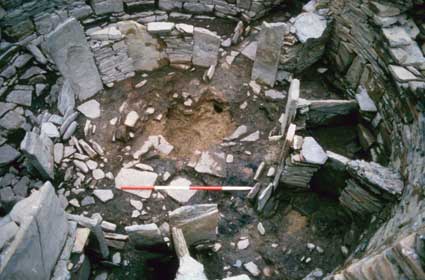 and doorjambs about 1.5 metres from the inner end, but no guardrooms. The floor of the broch was largely cleared out sometime later in the Iron Age and many features, such as the hearth, have all but disappeared.
and doorjambs about 1.5 metres from the inner end, but no guardrooms. The floor of the broch was largely cleared out sometime later in the Iron Age and many features, such as the hearth, have all but disappeared.
The interior was subdivided by upright slabs into three main areas and has a very similar layout to Bu, which is located nearby. In the centre is a near circular area about 4 metres in diameter. To the right of the entrance is a passage about 2 metres wide that runs about two-thirds of the way around the perimeter. The remaining space is taken up by three two-storeyed cupboards divided by partitions. There was an intramural cell about 1.3 metres above the floor on the west side that contained a set of stairs. The walls are only some 4 metres high and there was neither evidence for an upper floor—no scarcement nor evidence of wooden posts.

